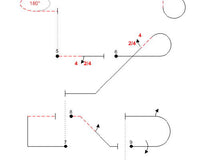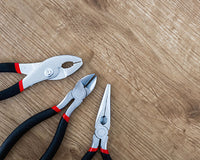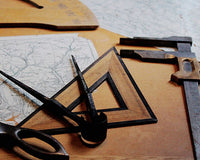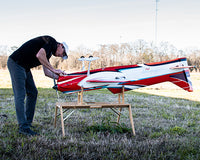This article is written by CK Aero Founder Bryan Hebert
Having an airplane that flies better than you is a special feeling. However, adjusting and improving the model and radio setup can sometimes be very confusing; you can easily get discouraged and make compromises. When I first started on this trimming journey I had no road map, no direction, and no skill. I only knew that I had to figure out where the shortcomings were actually coming from. I remember being exactly where you might be right now — frustrated, confused, and aggravated. “Who do I listen to?!” Through years of relentless work at the flying field and continual bench measurements, I managed to categorize the troubles into three areas:
- Is it me?
- Is it the airplane setup?
- Is it the radio setup?
Let's Start With Me...
Designing airplanes started for me at a very early stage in my pattern career. I was broke and there was no way I could find the money to compete, travel, and buy equipment. I did have help from a few top fliers back then, people like Paul Verger and Tommy Golson guided me in the right direction, but mostly it was my love of the idea of flying something I created that drove me to be successful. This determination paid off in the end but bear in mind I started this in 1988.
The key is to improve every aspect of the effort.
Everyone has shortcomings and they’re only based on three things: most importantly what are you able to recognize, then what are you really willing to change, and lastly (and often most underestimated) what are you capable of? The answer to that second question should be an emphatic “anything!” Improvements come slow but the key to improvement is recognizing you have the deficiency in your flying, addressing it, and then working on improving it. As I watch local competition on the circuit I see all kinds of talent hidden by poor equipment or poor radio setup, and I also see the problem of too much talent! Yes, talent can also get in the way of progression. You may think that’s impossible but the key to becoming the best competitor you can is to improve every aspect of the effort from the airplane, to the radio, to you.
You must have honesty and willingness to address the problem, whether it`s skill or equipment. This can take years to materialize in an individual. The discipline of a seasoned veteran is hard to come by early and is very rare in new competitors but the ones who embrace this approach first move up fast. This discipline (honest evaluation of your effort and short comings) is absolutely crucial to making hard work pay off. A good competitor will watch the competition to see what qualities he may lack and try to emulate the best. This is not to say we need to be copy cats but trying to earn a score from the judges takes a special understanding of what is missing in your flight to get the top scores. This can be simple stuff like not drawing straight lines between maneuvers, keeping your distance out, or constant roll rates. It can also be subtle things like the perfect way Jason can make an exit look out of a turn-around or the quality of Brett’s throttle management. All of these things add up to shape the scores you earn. The judges can see right away who is in control and who is not.
"Everybody's perception of perfection is different..."
This polish can play a very large part in the final numbers you receive and is the hardest to realize. The reason is, everybody`s perception of perfection is different. It`s a constant effort to be the best, most polished pilot in your class — this is what makes competition what it is. Embrace it and work towards goals to improve your weaknesses whether it`s rolling on the rudder in every roll or learning throttle management. These disciplines never stop needing polish and even the best will continually work on them because they are the final touches to perfection.
Is The Airplane My Problem?
If you think you are in control are you working too hard to compete with a poor setup? You have good skills as a pilot and you feel you have mastered the basics but the airplane is still not cooperating with you, or you feel it`s holding back your advancement. Stop, learn what you can about trimming, and address the problem as best you can. Use the trimming aids I have provided — they are not just words but major keys to success. The biggest fear to some is changing the airplane you just spent a year learning to fly and are somewhat satisfied with, but remember any improvement is still improvement. These small pieces will, over time, add up to major advancements as you progress through the classes.
Most guys move up before they are ready and they do a disservice to themselves in the long run. Take the time to absorb every aspect of your class and the skills required to fly the class. Do not move up until you have mastered them or you have pointed out. If there is a maneuver that you consistently earn a 7 on and you just accept that as a good score, it`s the perfect place to start. I hear guys all the time talk about being bored in a class; I say hogwash! There is always something to learn; if you have not earned straight tens in that class you can`t possibly be bored. If you can’t set your airplane up to fly the class perfect or if a set of maneuvers are constantly getting low scores take the time to measure the plane, tweak it, change it, learn from the changes, and I guarantee you will see improvements in your scores, effort, and knowledge and lose the boredom quickly.
Maybe I Just Need to Tweak My Program...
I coined the phrase, “Airplane setup and radio set up are two different things” years ago and that concept is more important than ever today. We must have a high standard of perfection in all aspects from the very start. This starts from the ground up — first airplane design, then airplane setup, radio layout, and finally radio programming. Brett will dive deeper into radio setup as a basic foundation to good geometry and consistent performance in another article but first you need to have the airplane CG and wing-thrust-incidence set up right on the bench to make the radio easy to adjust when it comes time to get the feel you are looking for. No amount of expo can fix a tail heavy or nose heavy airplane. No amount of conditions can fix poor incidence settings and no amount of dual rates can replace the skill to perform the maneuvers. This is why we categorize these three fundamentals.
Each discipline is responsible for its own work load. I recently helped a pilot who had a down line mix and was complaining of a trim problem while flying. As I inspected the setup I realized his mix for the down line was being turned on at half throttle (a big no no) and he didn`t even realize it. Having problems with the airplane climbing under power and the need for a knife edge mix don`t seem related until you start separating what could be the cause. I had to ask myself #1 Is it the pilot? #2 Is it the airplane setup? #3 Is it the radio setup? I found it was the radio setup but it was affecting the other two as well.
"Each discipline is responsible for its own work load"
From Brett: It’s even more complicated than it may seem! I actually setup my downline mix to reduce linearly up to ¼ throttle but I have to be astutely aware of when that may be affecting my trim and therefore, my setup. I chased this problem for a day while I was practicing for the 2014 USA Team Trials. If you don’t have the benefit of my experience and feel it could take you weeks or months to figure out what is causing this issue, like Bryan’s example above.
This is why it`s important to keep these things compartmentalized and understand what could be the cause, how to check it, and why it matters. After I fixed the problem his whole flight improved — he was not realizing it was affecting his whole routine. And to think, he was only trying to fix the down line. There are many more examples of this but I will save those for another time.
In closing I hope you can see how addressing each part of the setup process matters for the ability to get consistent results, improve your scores in competition, and continue to advance your knowledge and understanding of our beautiful sport.











